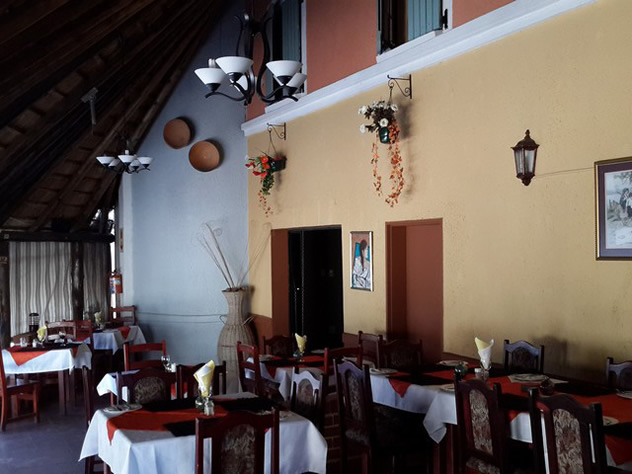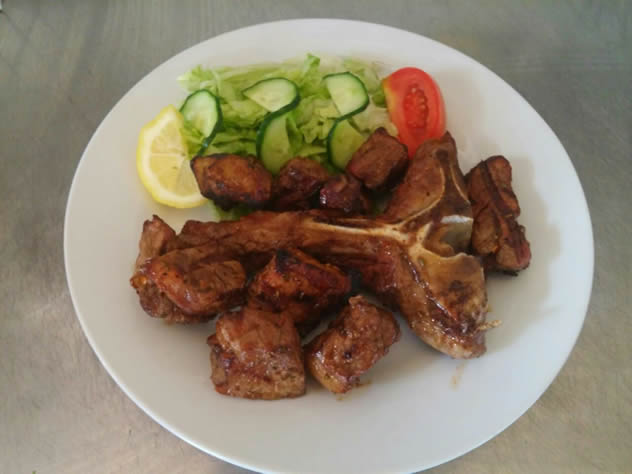News
Authentic African restaurants in Gauteng
Wednesday, June 24th, 2015In days gone by, you’d have had to search far and wide for items like yam or plantain, let alone order feather-light injera. Academics claim that cuisine is the last element to change during the process of acculturation (where people take on the culture of a surrounding majority), simply because eating happens mostly in the privacy of our homes, and – different from language or dress-code – these customs do not have to adapt around other people. Gauteng is lucky to play host to a number of restaurants serving diverse and authentic food from across the continent. Let’s rejoice in the culinary diversity of these 10 great African restaurants in Gauteng.
Abyssinia (Kensington, Johannesburg)
Niter kibbeh, the flavoursome butter used in Ethiopian stews, is made with different spices from kitchen to kitchen. At Abyssinia in Kensington, niter kibbeh is used liberally in key wot (beef stew) as well as in many of the other little mounds of saucy items accompanying injera (teff pancakes) on the mahberawi platter (R60). The selection may include tibs (sliced lamb or beef, pan fried in butter, garlic, onion and tomato) as well as kitfo, tibisi firfir and gomen besiga (Ethiopian greens and slices of beef cooked in butter). Abyssinia makes provision for fasting days, when they prepare beye-aynetu, a special dish eaten on Wednesdays and Fridays, as well as a vegetarian version of the mahberawi platter. Owner Amsale Debela and husband Dejerre are often around to introduce the uninitiated to Ethiopian cuisine, but any of the waiters would also happily assist.
Aliabie Restaurant (Sunnyside)
Making a strong case for successful cross-cultural partnerships, Ayele Abe from Ethiopia and his wife, Lorraine Tlaka from Mamelodi, are the owners of Aliabie Restaurant in Sunnyside’s Gerhard Moerdyk Street. This is a seriously busy restaurant, with large platters of injera flying out of the kitchen at an unbelievable pace. One of these platters comes with kitfo (minced beef marinated in a chilli-based spice blend) and niter kibbeh (in-house butter infused with marjoram). Other items are beso bela (a type of basil), Ethiopian cardamom, turmeric, ginger, garlic, cumin, coriander, and nutmeg served with a mild type of cottage cheese called ayibe (here made from South African amasi). The meat is unceremoniously cut from two large legs of beef hanging in a little wooden cage. Other injera plates are served with cabbage stew, shiro (smooth chickpea stew), misir (lentil stew), fried beetroot and carrot, potato and carrot stew, and fresh tomato and onion salad. Another delicious must-try are the fabulously filling and hearty ambasha breads.
Kin Malebo (Parktown, Johannesburg)
From street level, Kin Malebo might be hard to find, its courtyard surrounded by thatched roofs that obscure the sign and give shelter to some outside pool tables. While no one appears to eat outside in winter, inside the music is so lively that eating is not the first consideration. This is home to serious Congolese food and the ladies in charge of the burners and pans are all happy to share their country’s cuisine. Try a whole fried fish, such as red fish or carapau, served with either pap or rice. There is also pondu, a traditional Congolese dish made from cassava leaves with onion, red palm oil and chillies; another Lingala dish called ngai ngai, a type of green vegetable stew; matembele, a dish of sweet potato leaves; or any number of other regional Congolese specialities such as mipanzi, ndongo-ndongo and fumbura.
La Terrasse Rooftop Café (Menlo Park, Pretoria)
Situated on the busy thoroughfare of Atterbury Road, La Terrasse Rooftop Café is a welcome retreat. The restaurant is split between the rooftop terrace and an area inside, where there is also a shop selling beautiful Moroccan house- and kitchenware. Platters are a great way to share, and may include hummus, baba ganoush, kefta and zaalouk (an aubergine relish made with tomato, paprika, green olives and balsamic). While they also serve other specialities such as beetroot and pomegranate soup with yoghurt and walnuts, it is the tagines that draw the flocks of people. Opt for the lamb tagine with dates and honey; beef tagine with sweet potato; or the apple or butternut tagine – all served with jewelled couscous.

La Terrasse Rooftop Café. Photo courtesy of the restaurant.
Ninho Pica Pau (Hatfield, Pretoria)
Located in the same premises that housed the erstwhile and legendary La Maison in Hilda street, a small selection of Mozambican food items – pretty spicy since no-one shies away from fresh chillies – are served among a number of more authentically Portuguese dishes. Apart from examples of bacalhau grelhado and peri-peri chicken, the bitoque (steak, eggs, chips and rice) is skilfully prepared. Do try their version of dobrada, a lovely stew of tripe and white beans, even though it’s not made like the traditional Mozambique version with black tripe or mogodu. They also prepare a local version of feijoada (Moçambicana) with red beans, pork trotters and tripe (in Brazil made with black beans) and, of course, an array of fabulous fish off the coast of Mozambique, grilled prawns, prawn curry, crab curry and seafood rice. Judging by how many staff from the Mozambique Embassy appear to support the place, they must be fairly authentic and doing things just right.

Ninho Pica Pau. Photo courtesy of the restaurant.
Queen of Sheba (Norwood, Johannesburg)
Tucked into a small side street off Grant Avenue in Norwood lies an Ethiopian gem. The rather dark interior is probably better experienced at night, but during the daytime a few tables are set out on the pavement. Their injera is made from a mix of teff and rice flour and all fermentation and baking is done in house. Their chicken doro wot takes around 3 hours to prepare and is made predominantly from chicken drumsticks, loads of white onions and berber spices – a rich, chilli dish. For vegetarians they have a shiro wot, with their version of the famous chickpea soup made from chickpea powder, as well as their misir wot, a lovely lentil version.
Savana Restaurant (Arcadia, Pretoria)
Tucked away in a smallish shopping centre (below a block of flats within walking distance of the Pretoria Art Museum) is a bright little restaurant serving central African dishes such as tilapia served with pap and pondou, that fabulous Congolese sauce/stew made from cassava leaves and palm oil. Another must have is the goat soup with a choice of side dishes (R50); jollof rice and chicken (R40); egusi soup, the West African Nigerian dish made with a type of gourd seed, semolina and some vegetables like bitterleaf or okra. Another West African speciality to try is aloco (plantains fried in palm oil), attiéké (also spelled acheke) a side dish of cassava couscous, which originated in Côte d’Ivoire and Benin, or some Francophile dishes such as riz rouge, beignets and poisson braise.
Tajine Moroccan Restaurant (Benoni)
Believe it or not, Benoni is home to one of the busiest Moroccan restaurants in Gauteng. Try their charred halloumi with ras el hanout spice mix and flavoursome orange blossom (R55); koutbaan, a lamb kefta kebab with pita and salad; and the beetroot salad layered with goat’s cheese marinated in cumin and olive oil, which sounds fantastic. They serve a traditional harira soup with beans, lentils and chickpeas, served with freshly baked bread. Mechoui is slow-roasted lamb shank with spices, thyme and tomato, served with saffron and rosewater rice, grilled new potato or couscous. B’stilla is a Moroccan classic, and even though they make it with chicken and not the traditional pigeon, it is still authentic in flavours of almond and orange blossom wrapped in phyllo and served with a side salad. They have a number of tagines: pumpkin, sweet potato and lentil; lamb with spicy date and pomegranate; or lemon-olive chicken. Their mukabalatt platter forms part of a set menu and is presented with preserved lemon, harissa, rose carrots, and lemon marinated olives, bassara (a white bean and mint paste), zeilook (roasted aubergine), Moroccan hummus, and cucumber and garlic yoghurt.
Tsega Restaurant (Sunnyside, Pretoria)
In the 1990s the little Gerhard Moerdyk Village in Sunnyside was a hive of activity, with restaurants and art shops in 1920s houses. Today, this spot is still lively, but perhaps Mediterranean has moved over for Ethiopian, and the French crêpe shop has become a French Congolese restaurant to meet the needs of the target audience. One of these little period houses is occupied by another Ethiopian restaurant called Tsega. Unlike Aliabie, where the audience appears to be a little more cross-cultural and slightly older, the guests at Tsega strut their stuff around the pool tables, which indicates a home-away-from-home approach to food and entertainment. A large espresso machine means that you can sample anything from a cappuccino to a buna, the traditional Ethiopian coffee. A special corner is devoted to the stools and charcoal burner needed to prepare and present the traditional Ethiopian coffee ceremony, for which raw beans are toasted, ground, brewed with spices and served with sugar or salt and snacks, such as popcorn.
Zemara (CBD, Pretoria)
Jackie Picard’s restaurant and adjacent guest house, which she runs with her husband and son, offers mostly central African food. Expect traditional Congolese, Ugandan or Rwandan food here, even though there may also be some items from East and West Africa from time to time. The menu features all the tastes and flavours of African and Arabic cuisines, such as grilled tilapia; chicken stew with palm nut; game dishes in peanut sauce; deep-fried plantain; a lovely vegetable dish made from cassava leaves; yam dishes; pilau rice with chicken; and goat and tomato stew, a classic Tanzanian/Zanzibari dish. Also recommended is their mandazi, a dumpling-type bread flavoured with sugar and spices, which is served along with all the other food.

Zemara. Photo courtesy of the restaurant.













Do you have any outlet in mumbai and anywhere in india.
No, sorry Atul. We’re based in South Africa.
where can i buy cassava leaf plasa stew in south africa(pretoria)? my cravings are so bad they want.